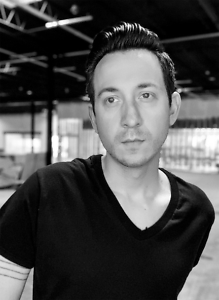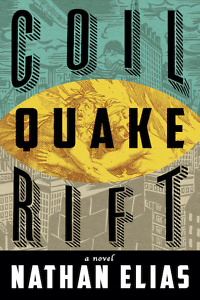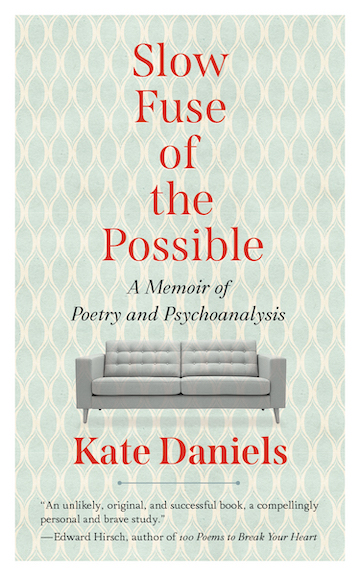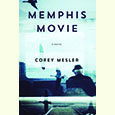Not the End of the World
Desperate characters in Nathan Elias’ debut novel plunge into alternate realities
For a novel set in Los Angeles, a city legendary for its year-round sunshine, Nathan Elias’ Coil Quake Rift is strangely inundated with darkness. The gloom descends in the opening pages when Tiffany, a physicist studying black holes and dark matter, commits suicide. An experiment she scheduled for a year after her death causes a city-wide blackout and an earthquake that opens a light-swallowing chasm in Venice Beach. The surviving characters, befogged by grief and drawn toward the “rift,” ponder diving into the unknown, if only to see if there is light on the other side.

The novel’s cast includes two couples who migrated to LA for a new start and learn that happiness might be as flickering as Hollywood fame. Tiffany and Knox left Toledo so that she could join a research team at UCLA working on a (fictional) large hadron collider and he could pursue a career as documentary filmmaker. Florida natives Margot and Jason come west for his work and hope to start a family; after she suffers a miscarriage, she seeks comfort in the arms of Knox.
Margot’s arrival hastens Tiffany’s departure, in the ultimate sense — until, that is, we learn more about the mini-black hole that Tiffany has posthumously created near the beach. Maybe the world we know, one of many “coils” in Tiffany’s formulation, has porous boundaries; maybe the earthquake caused a rift that enables travel to parallel realms where the dead in our coil continue to live. Maybe the heartbreaks and betrayals never happened.
Such are the possibilities raised by Elias’ inventive and philosophically engaging debut novel, which plays with the themes of love and loss that Elias, a Nashville resident, explored in his 2020 story collection The Reincarnations. His fictions employ sci-fi premises but don’t fit within the parameters of the sci-fi genre, primarily because Elias maintains a distance from his own narrative devices. He doesn’t appear particularly interested in the plausibility of a vortex suddenly appearing on a tourist beach. What intrigues him is the potential for human metamorphosis. Like Ovid’s heroes, the characters in Coil Quake Rift must summon the courage and ingenuity to transform themselves.
 The motif of pregnancy, that most momentous transformation, recurs throughout the novel. The experience is not uniformly joyful. On the night of the earthquake/blackout, Margot reveals her pregnancy to Knox, then confesses her desire to get an abortion to avoid “another unexpected loss.” In one of the letters that Tiffany leaves for Knox, she too writes about being pregnant, accreting sadness to her self-destruction. When a young girl appears near the rift, without parents and bearing a strong resemblance to Margot, we wonder if the chasm is actually a portal that has conveyed the girl from an alternate dimension. In the fabric of this novel, that possibility is no more outlandish that the ordinary miracle of childbirth.
The motif of pregnancy, that most momentous transformation, recurs throughout the novel. The experience is not uniformly joyful. On the night of the earthquake/blackout, Margot reveals her pregnancy to Knox, then confesses her desire to get an abortion to avoid “another unexpected loss.” In one of the letters that Tiffany leaves for Knox, she too writes about being pregnant, accreting sadness to her self-destruction. When a young girl appears near the rift, without parents and bearing a strong resemblance to Margot, we wonder if the chasm is actually a portal that has conveyed the girl from an alternate dimension. In the fabric of this novel, that possibility is no more outlandish that the ordinary miracle of childbirth.
In Elias’ ruptured world, commonplace phrases are given new twists or rejected altogether. Knox tells Margot, “You can’t erase the past.” As the story’s bizarre events unfold, they adopt more flexible conceptions of time. “Maybe the future is the synthesis of the past and present,” Margot thinks. Indeed, as Tiffany details her notions regarding string theory and “spirit particles,” she posits that time “is on an endless loop, spinning and spinning. A snake eating its own tail.” The leader of Tiffany’s collider project once told her that “our work could change the world.” Now, “he’s saying that our work will change history.”
Elias spaces out the narrative pyrotechnics so that readers never lose track of the story’s key elements. He’s especially adroit in handling time, braiding Margot and Knox’s escape from their apartment with Tiffany’s letters, written a year earlier. As the couple lurches toward reality-altering dilemmas, Tiffany lucidly describes the steps she takes to create the cataclysm. By the time Margot and Knox join Jason to confront the rift, we are prepared to enter alternate worlds.
Particle physics and Ovid’s Metamorphoses are the primary reference points in this highly allusive novel. Knox recalls that his initial attraction to Tiffany was based on her “endless curiosity” that encompasses mythology in addition to quantum science. She is fascinated by the story of Orpheus and Eurydice, a man traveling to Hades to retrieve his dead lover. The novel is not always so highbrow: They meet at a college party, playing beer pong and sharing their enthusiasm for Richard Linklater movies.
As Coil Quake Rift rushes forward, recurring questions emerge: What does it take to start a family? What is the nature of reality? How can we reconcile the traumatic past with an uncertain future? Through all the turmoil, the possibility of happiness remains viable. In the blackout, Knox offers Margot room-temperature tacos. “It’s not the end of the world,” he jokes. Maybe, Elias suggests, it is the beginning of a new one.

Sean Kinch grew up in Austin and attended Stanford. He earned a Ph.D. from the University of Texas. He now teaches English at Montgomery Bell Academy in Nashville.


